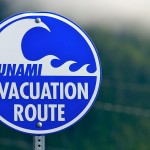Researchers at the University of Alaska Fairbanks have been looking into the science behind tsunami risk for Alaska’s coastal communities.
Tsunami modelers from the University of Alaska Fairbanks Geophysical Institute, Elena Suleimani and Dmitry Nicolsky, recently shared their discoveries with Juneau and Sitka in hopes of better preparing those communities for potential tsunamis.
Alaska is home to 60 and 70 coastal communities that could be hit by tsunamis. Alaska has the largest amount of coastline of any state in the country, the Fairbanks Daily News-Miner reported Sunday.
Some of the information Suleimani and Nicolsky share is provided in the form of an inundation map. These maps measure certain types of ocean currents that can cause water surges along Alaska’s coastline for hours after the initial tsunami.
 During their recent visits to Juneau and Sitka, Suleimani and Nicolsky gave presentations on tsunami safety and preparedness and provided the cities with their research findings and draft maps of dangerous coastal areas.
During their recent visits to Juneau and Sitka, Suleimani and Nicolsky gave presentations on tsunami safety and preparedness and provided the cities with their research findings and draft maps of dangerous coastal areas.
“We have a list of at-risk communities, and then we create these maps for them,” Suleimani said. “We start with the complete assessment of a tsunami risk, and then we make the maps based on the risk to the community.”
In a tsunami, waves can continue hitting the shore for up to 24 hours, and the first wave is not always the largest, Suleimani said.
“You might have 10 minutes,” Suleimani said. “Don’t waste any time. You take your emergency kit and run.”
Topics Catastrophe Natural Disasters Alaska
Was this article valuable?
Here are more articles you may enjoy.


 California Chiropractor Sentenced to 54 Years for $150M Workers’ Comp Scheme
California Chiropractor Sentenced to 54 Years for $150M Workers’ Comp Scheme  North Carolina Adjuster and Son Charged With Embezzlement in Roof Jobs
North Carolina Adjuster and Son Charged With Embezzlement in Roof Jobs  JPMorgan Client Who Lost $50 Million Fortune Faces Court Setback
JPMorgan Client Who Lost $50 Million Fortune Faces Court Setback  California Sees Two More Property Insurers Withdraw From Market
California Sees Two More Property Insurers Withdraw From Market 

